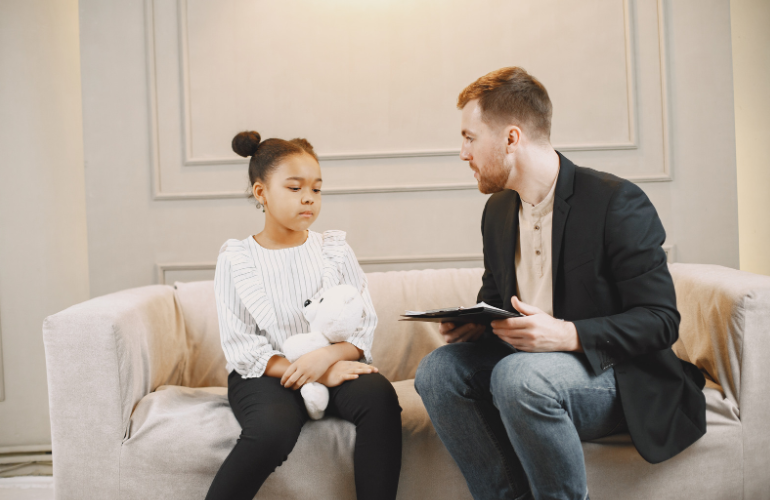Trauma and Sensory Processing
Both trauma experiences and the sensory system are known to be complex among health professionals. So, how do these complex systems impact each other? Let’s start with a recap of both.
The Sensory Systems
The sensory system receives and processes information that allows an individual to be aware of their environment, and sensory processing is the brain’s ability to make those connections (Gadhvi et al., 2023). The sensory system contains the visual system (sight), the auditory system (hearing), the tactile system (touch), the olfactory system (smell), the gustatory system (taste), the vestibular system (head movement in space), the interoceptive system (interpretation of bodily feelings) and the proprioceptive system (body movement in space). Sensory processing disorder is the inability to process this input and results in someone feeling over or under-sensitive to said input.
Trauma
You have probably heard many people say, “that was traumatizing” or, “that was triggering”. However, trauma and triggers are more complex than most people think. Trauma is an emotional response to a terrible event like an accident, assault, or natural disaster (American Psychological Association [APA], 2023). This can be short-term or long term depending on the event, person, or support received. Immediately after an event, shock and denial are typical, but longer term reactions can occur and may include unpredictable emotions, flashbacks, strained relationships, and even physical symptoms. Some people who experience trauma can bounce back to normal routine, but others may struggle longer or have additional symptoms, even potentially being diagnosed with Post-Traumatic Stress Disorder or Complex Post-Traumatic Stress Disorder. Children who experience adverse childhood experiences (ACEs) may have a mental illness diagnosis or disorder. In fact, children with a score of 4 or more on the ACEs quiz had significantly more negative mental or behavioral effects and showed less resilience compared to those scoring below a 4 (Goldenson et al., 2020). This does NOT necessarily mean all children with ACEs will have trauma or mental/behavioral challenges. ACEs include abuse (physical, emotional, or sexual), neglect (physical or emotional), or household dysfunction (family member[s] with mental illness, incarcerated, substance abuse, divorce, or witnessing domestic violence). If you want to learn more about you or your child’s ACEs you may take the quiz here, but there may be some difficult questions/content.
How are they related?
There is no easy answer, but it is clear that they affect one another. Our memory system consists of networks of related information, where activation of one network helps retrieve memories (Van der Kolk, 2002). Sensation (or sensory input) is one of the networks that works to retrieve memories. So, after exposure to specific sensory triggers, a child may feel or act as if they were traumatized all over again, even if that trigger wasn’t “scary” itself. For example, if a child was sitting on a shag carpet while witnessing substance abuse in the household, they may be hypersensitive to shag material, and have a large reaction when coming into contact with it. Additionally, many people are able to recount their traumatic experiences in sensory details, recounting what they smelled or heard at the time of the event. Some people do not remember traumatic events, but even those who remember them after a longer period of time, or have received a narration of the event in great detail, will still re-experience the event via their sensory perceptions (Van der Kolk, 2002). Parts of the brain also turn sensory stimuli into emotional signals, creating emotional responses. So, when we know a child has a history of trauma, and is emotionally or behaviorally reacting to certain sensations in a way we might not understand, it is important to step back and remember this information about trauma and sensory processing.
How can this connection improve?
If you believe you or your child have a history of trauma that is impacting your sensory processing, it is important to seek guidance from an occupational therapist and a behavioral therapist. An occupational therapist will help to eliminate or alleviate the reactions to certain sensations, oftentimes through sensory integration therapy, while a behavioral therapist can work with you to overcome the effects of the experienced traumatic event, and the mental and behavioral effects it can have. Oftentimes these professionals can work together to figure out a strategy/plan that is best for you or your child.
Some strategies to try at home when your child is having a large response to sensory input that you believe is due to trauma are:
Act as a co-regulator. Be your child’s role model and remain calm and stable. Deep breathing, blowing, and sucking activities are helpful in promoting a calm and stable emotional state.
Include their favorite safe sensory-activities in their daily routine- this gives them autonomy and may help them remain regulated throughout the day.
If you anticipate times when your child may struggle, plan in a sensory regulating activity prior.
We also have some courses and handouts to help better understand trauma and sensory processing that you can purchase from our site. Trauma is challenging to overcome, but it is possible with the right support and strategies.
References
American Psychological Association [APA]. (2023). Trauma. https://www.apa.org/topics/trauma
American Society for the Positive Care of Children. (n.d.) Take the ACEs quiz. https://americanspcc.org/take-the-aces-quiz/
Cleveland Clinic. (2023). CPTSD (Complex PTSD). https://my.clevelandclinic.org/health/diseases/24881-cptsd-complex-ptsd
Gadhvi, M., Moore, M.J., & Muhammad, W. (2023). Physiology, sensory systems. StatPearls. https://www.ncbi.nlm.nih.gov/books/NBK547656/
Goldenson, J., Kitollari, I., & Lehman, F. (2020). The relationship between ACEs, trauma-related psychopathology and resilience in vulnerable youth: Implications for screening and treatment. Journal of child & adolescent trauma, 14(1), 151–160. https://doi.org/10.1007/s40653-020-00308-y
Van der Kolk, B.A. (2002). Trauma and memory. Psychiatry and clinical neurosciences. https://doi.org/10.1046/j.1440-1819.1998.0520s5S97.x



